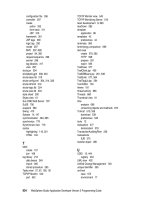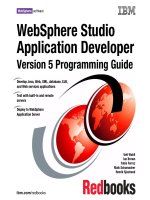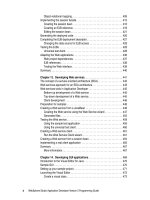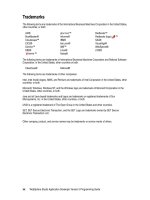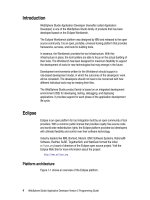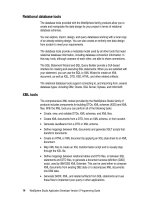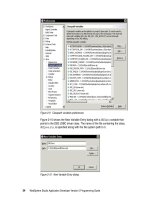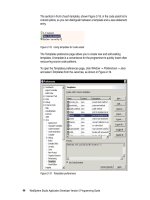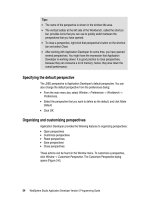WebSphere Studio Application Developer Version 5 Programming Guide part 4 ppt
Bạn đang xem bản rút gọn của tài liệu. Xem và tải ngay bản đầy đủ của tài liệu tại đây (171.04 KB, 10 trang )
4 WebSphere Studio Application Developer Version 5 Programming Guide
Introduction
WebSphere Studio Application Developer (hereafter called Application
Developer) is one of the WebSphere Studio family of products that has been
developed based on the Eclipse Workbench.
The Eclipse Workbench platform was designed by IBM and released to the open
source community. It is an open, portable, universal tooling platform that provides
frameworks, services, and tools for building tools.
In essence, the Workbench provides the tool infrastructure. With this
infrastructure in place, the tool builders are able to focus on the actual building of
their tools. The Workbench has been designed for maximum flexibility to support
the development of tools for new technologies that may emerge in the future.
Development environments written for the Workbench should support a
role-based development model, in which the outcomes of the developers’ work
will be consistent. The developers should not have to be concerned with how
different individual tools may be treating their files.
The WebSphere Studio product family is based on an integrated development
environment (IDE) for developing, testing, debugging, and deploying
applications. It provides support for each phase of the application development
life cycle.
Eclipse
Eclipse is an open platform for tool integration built by an open community of tool
providers. With a common public license that provides royalty free source code
and world wide redistribution rights, the Eclipse platform provides tool developers
with ultimate flexibility and control over their software technology.
Industry leaders like IBM, Borland, Merant, QNX Software Systems, Rational®
Software, RedHat, SuSE, TogetherSoft, and WebGain formed the initial
eclipse.org board of directors of the Eclipse open source project. Visit the
Eclipse Web Site for more information about the project:
Platform architecture
Figure 1-1 shows an overview of the Eclipse platform.
Chapter 1. Introduction and concepts 5
Figure 1-1 Eclipse platform
Eclipse is a platform that has been designed from the ground up for building
integrated regardless of presentation technology and application development
tooling. By design, the platform itself does not provide a great deal of end user
functionality. The value of the platform is what it encourages: rapid development
of integrated features based on a plug-in model.
Eclipse provides a common user interface (UI) model for working with tools. It is
designed to run on multiple operating systems while providing robust integration
with each underlying OS. Plug-ins can be programmed to the Eclipse portable
APIs and run unchanged on any of the supported operating systems.
The Eclipse platform uses the model of a common Workbench to integrate the
tools from the end user's point of view. Tools that you develop can be plugged
into the Workbench using well defined hooks called extension points.
The underlying platform runtime uses the same extension model to allow plug-in
developers to add support for additional file types and customized installations,
such as Web servers, workgroup servers, and repositories. The artifacts for each
tool, such as files and other data, are coordinated by a common platform
resource model.
The platform gives the users a common way to work with the tools, and provides
integrated management of the resources they create with plug-ins.
6 WebSphere Studio Application Developer Version 5 Programming Guide
Workbench features
The Eclipse Workbench provides a set of APIs, models, and frameworks for
developing source editors and other user interfaces, as well as access to
common services for resource management, debugging, and team
programming.
The main features of the Eclipse Workbench are:
Plug-in based tooling
Role-oriented development tools
Vertical and horizontal integration
Open standards
Open team environment
File based IDE
Plug-in based tooling
The Workbench provides a flexible plug-in platform. Different tools can plug in to
the Workbench, with each tool providing new functionality to be added to the
Workbench or to already existing plug-ins. Each plug-in integrates with the
Workbench and with the other tools. Ideally the end-user should not notice any
difference when moving from one tool to another.
By programming to the portable Eclipse APIs, plug-ins can run unchanged on
any of the supported operating systems using a common user interface model.
The Workbench is designed to run on multiple operating systems while providing
robust integration with each one.
At the core of Eclipse is an architecture for dynamic discovery of plug-ins. The
platform handles the logistics of the base environment and provides a standard
user navigation model. Each plug-in can focus on performing a small number of
tasks well, without having to provide the supporting infrastructure. Some
examples of such tasks are defining, testing, animating, publishing, compiling,
debugging, and diagramming.
Because the Workbench is based on an open architecture, each plug-in
development team can focus on their area of expertise. This enables the team
management experts to build the back-end interfaces and the usability experts to
build the end user tools. If these are well designed, and use the standard APIs,
significant new features and levels of integration can be added to the Workbench
and Workbench based products without impacting other tools.
Chapter 1. Introduction and concepts 7
Role-oriented development with consistent look and feel
The Workbench is designed to provide special support for a particular e-business
development role, or for a set of roles.
Within the Workbench based products, task-oriented perspectives filter out much
of the overall complexity, and present the developer only with those functions that
are relevant to the task at hand.
Users can switch perspectives depending on what they are working on at any
given moment, or depending on their current role in the project.
Because different developers are accustomed to working in different ways, any
perspective can be further customized. And because all tools and perspectives
are built using the Eclipse Workbench technology, they share a common look and
feel, which reduces learning curves and help maximize developer productivity.
All development resources for all projects are stored in a single repository,
therefore developers have consistent team support for their projects, and are
able to easily share their work products.
Vertical and horizontal integration
Traditionally software vendors have provided vertical tools, forcing customers to
do their own integration. The purpose of the Eclipse Workbench is to provide a
platform that software vendors can easily extend. ISVs have already embraced
this technology and are actively building tools on this base.
As an example, every WebSphere Studio family of products that is built on the
Workbench offers a set of already integrated tools, freeing you to focus on
building applications rather than on integrating tools. Furthermore, you can easily
integrate other tools (from other vendors or locally developed), as long as they
conform to the Workbench standard plug-in protocol.
Open standards
The whole Eclipse Workbench, as well as all products of the WebSphere Studio
family of products, are built on open standards and the code that they generate
also complies with open standards.
This allows you to build and deploy state-of-the-art, server-side applications that
conform to the Servlet 2.2, JavaServer Pages 1.1, and EJB 1.1 specifications.
8 WebSphere Studio Application Developer Version 5 Programming Guide
Open team development
Application development teams are becoming more distributed, more diverse,
and are under increasing pressure to deliver solutions quickly. In such an
environment it is critical to have development tools that can support these needs,
while at the same time addressing personalized requirements. The team
development environment for all products based on the Eclipse Workbench
supports pluggable repositories rather than mandating any proprietary
repository, and support an optimistic concurrency model.
File-based IDE
The Eclipse Workbench is a platform for building file-based IDEs. All content is
saved as files. Workbench resources, such as Java classes and HTML files, are
stored in the file system, making them easy to access.
WebSphere Studio products
The WebSphere Studio product family is built on top of the Eclipse Workbench as
a set of plug-ins conforming to the Workbench’s open standard APIs.
The WebSphere Studio family of products currently has the following members
(Figure 1-2):
WebSphere Studio Site Developer Advanced
WebSphere Studio Application Developer
WebSphere Studio Application Developer Integration Edition
WebSphere Studio Enterprise Developer
These products provide support for end-to-end development, testing, and
deployment of Web and J2EE applications.
The WebSphere Studio product family provide integrated development tools for
most e-business development roles including Web developers, Java developers,
business analysts, architects, and enterprise programmers. The customizable,
targeted and role-oriented approach of the Workbench will be a common
characteristic of future products in the WebSphere Studio family.
Chapter 1. Introduction and concepts 9
Figure 1-2 WebSphere Studio family
WebSphere Studio Site Developer
Site Developer is an IDE intended for Web developers who develop and manage
complex Web sites. It is an easy-to-use environment that minimizes the time and
effort required to create, manage, and debug multi-platform Web sites. It is
designed according to the J2SE and J2EE specifications and supports JSPs,
servlets, HTML, JavaScript, and DHTML. It further includes tools for developing
images and animated GIFs.
Site Developer enables Web developers to use their favorite content creation
tools in conjunction with the built-in local and remote publishing capabilities.
Using Site Developer, you can develop Web applications that use the following
technologies.
JSPs—A simple, fast, and consistent way to extend Web server functionality
and create dynamic Web content. JSPs enable rapid development of Web
applications that are server and platform-independent.
Servlets—Server code that executes within a Web Application Server.
Web services—Self-contained, modular applications that can be described,
published, located, and invoked over the Internet or within intranets.
WebSphere Studio Workbench
Application Developer
Application Developer Integration Edition
IBM's commerically supported version of Eclipse
Basis for IBM Tooling
+
+
Enterprise Developer
Eclipse Workbench
Provides frameworks for tool builders
to focus on tool building
+
Site Developer
User: Web Developer
Function:
HTML/JSP/Servlet
Struts Tools
Web Services Tools
XML Tools
Java Visual Editor
Target Runtime:
WAS AE, WAS ND
User: J2EE Developer
Function:
EJB Tools
Performance and
Trace tools
Component Test tools
ClearCase LT OEM
Target Runtime:
WAS AE, WAS ND
User: Advanced J2EE
Developer
Function:
Access existing EIS
applications using
JCA
Visual Service Flow
Choreography
Target Runtime:
WAS AE, ND, WAS E
User: Enterprise
Developer
Function:
Create new EIS
applications as part
of a J2EE app
EGL Tools
Develop/Maintain
z/OS Apps
COBOL
PL/I
ASM
COBOL XML
Enablement
Target Runtime: WAS
AE, ND, WAS E, z/OS
10 WebSphere Studio Application Developer Version 5 Programming Guide
WebSphere Studio Application Developer
Application Developer is designed for professional developers of Java and J2EE
applications, who require integrated Java, Web, XML, and Web services support.
It includes all of the features of Site Developer, and adds tools for developing EJB
applications, as well as performance profiling and logging tools for both local and
remote execution.
Developers can quickly build and test business logic and enhance the
presentation artifacts with built-in Web creation tools inside the Application
Developer IDE before deploying to a production server.
Using the performance profiling and tracing tools, it is possible to detect
application performance bottlenecks early in the development cycle.
Furthermore, the built-in test environment for WebSphere Application Server and
advanced tools for code generation help shorten the test cycle.
WebSphere Studio Application Developer Integration Edition
Integration Edition includes all of the functionality in Application Developer, plus:
Powerful graphical tools to help you quickly and easily build custom
application adapters to integrate your J2EE application with your back-end
systems, helping you save time and money by reusing existing resources.
Visual flow-based tools that increase developers productivity by allowing them
to visually define the sequence and flow of information between application
artifacts such as adapters, Enterprise JavaBeans components and Web
services.
Wizards that help in building and deploying complex Web services out of
adapters, EJB components, flows, and other Web services.
Support for the full set of Enterprise services provided by WebSphere
Application Server Enterprise Edition such as business rule beans,
internationalization, and work areas that deliver additional integration
capabilities, developer productivity, and business agility.
WebSphere Enterprise Developer
Enterprise Developer includes all of the functionality in WebSphere Studio
Application Developer Integration Edition, plus among others:
Integrating transactional environments such as CICS® and IMS™
Creating new EIS applications as part of a J2EE application
Developing and maintaining z/OS® applications
Supporting Java, COBOL, PL/I, and EGL (enterprise generation language)
development
Chapter 1. Introduction and concepts 11
Implementing Struts-based MVC applications using connectors and EGL.
Here is another core technology that is integrated within Enterprise Developer:
WebSphere Studio Asset Analyzer (WSAA)—Identifies application processes
and connecting points, and provides the ability to generate components from
existing code.
Enterprise Developer provides a visual construction and assembly based
environment supporting the implementation of enterprise level applications,
including support for the multiple developer roles and technologies required by
those applications. Some examples of technologies supported are HTML, JSPs,
servlets, EJBs, COBOL, EGL, PL/I, and connectors.
What is new in Application Developer Version 5
Application Developer Version 5 contains many new and improved features. For
details about changes to specific product features, refer to the readme file located
in the readme subdirectory of both the installation CD and the WebSphere Studio
installation directory (Windows® users can also access the readme file directly
from the Start menu, after installing WebSphere Studio).
Here are some highlights of the new features:
Support for J2EE 1.3, including EJB 2.0, Servlet 2.3, and JSP 1.2 levels
Concurrent support for WebSphere Application Server V4 (J2EE 1.2) and
WebSphere Application Server V5 (J2EE 1.3)
Enables WebSphere Application Server Version 4 users to adopt the latest
innovations from Eclipse Version 2, and enhancements from Application
Developer Version 5 without server upgrade
Numerous updates and new functions for Java, Web services, XML,
Database, Test and Analysis, and Web components
Specialized support for Struts, which is a set of Java classes and JSP tag
libraries that provide a conceptual framework for developing Web applications
New Visual Editor for Java (Java-based client for building GUI components
with Swing or AWT)
XSL source editor; new wizards to help you create your XSL files
12 WebSphere Studio Application Developer Version 5 Programming Guide
Migration from previous versions
The root directory of Application Developer’s installation CD contains a migration
guide that is provided in the migrate.pdf and the migrate.html files.
This migration guide discusses how you can:
Target WebSphere Application Server Version 4.0.x versus Version 5
Migrate from WebSphere Studio Application Developer Version 4.0.x
Migrate from WebSphere Studio Application Developer Version 5 Beta
Migrate from WebSphere Studio Classic to WebSphere Studio Application
Developer
Migrate from VisualAge for Java to WebSphere Studio Application Developer
Migrate from WebSphere Studio Application Developer for Linux
Migrate enterprise beans from VisualAge for Java to WebSphere Studio
Application Developer
Migrate from EJB 1.0 to EJB 1.1 or to EJB 2.0
Migrate from VisualAge for Java Visual Composition Editor to Visual Editor for
Java
Convert from VisualAge for Java Persistence Builder to EJB 2.0
Build setup (library JARs, dependant project JARs, Ant builds)
The migration guide also provides some migration examples that show you, step
by step, how to migrate to Version 5 from previous versions.
Tools
The WebSphere Studio product family include the following basic tools:
Web development
Relational database
XML
Java development
Web services development
Team collaboration
Integrated debugger
Server tools for testing and deployment
Enterprise JavaBean development tools (not in Site Developer Advanced)
Performance profiling (not in Site Developer Advanced)
Plug-in development
Chapter 1. Introduction and concepts 13
Web development tools
The professional Web development environment provides the necessary tools to
develop sophisticated Web applications consisting of static HTML pages, JSPs,
servlets, XML deployment descriptors, and other resources.
Wizards are available to generate ready to run Web applications based on SQL
queries and JavaBeans. Links between Web pages can be automatically
updated when content is moved or renamed.
The Web development environment brings all aspects of Web application
development into one common interface. Everyone on your Web development
team, including content authors, graphic artists, programmers, and Web
masters, can work on the same projects and access the files they need.
Such an integrated Web development environment makes it easy to
collaboratively create, assemble, publish, deploy, and maintain dynamic,
interactive Web applications.
The Web development tools provide the following features:
Support for latest Web technology with an intuitive user interface
Advanced scripting support to create client-side dynamic applications with
VBScript or JavaScript
Web Art Designer to create graphic titles, logos, buttons, and photo frames
with professional-looking touches
Animated GIF Designer to create life-like animation from still pictures,
graphics, and animated banners
Over 2,000 images and sounds in the built-in library
Integrated, easy-to-use visual layout tool for JSP and HTML file creation and
editing
Web project creation, using the J2EE-defined hierarchy
Creation and visual editing of the Web application deployment descriptor
(web.xml) file
Automatic update of links as resources are moved or renamed
A wizard for creating servlets
Generation of Web applications from database queries and JavaBeans
J2EE WAR/EAR deployment support (not in Site Developer)
Integration with the WebSphere unit test environment
